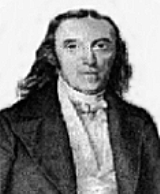
Johann Salomo Christoph Schweigger
Encyclopedia
Johann Salomo Christoph Schweigger (8 April 1779 – 6 September 1857) was a German chemist
, physicist
, and professor
of mathematics
. In 1811, he proposed the name "Chlorine
" for the substance discovered in 1774 by Carl Wilhelm Scheele
and properly identified by Humphry Davy
as an element in 1810. In 1820 he built the first sensitive galvanometer
naming it after Luigi Galvani
. He created this instrument, acceptable for actual measurement as well as detection of small amounts of electric current, by wrapping a coil of wire around a graduated compass.
He is the father of Karl Ernst Theodor Schweigger
and adopted one of his students Franz Wilhelm Schweigger-Seidel as his own son.
Chemist
A chemist is a scientist trained in the study of chemistry. Chemists study the composition of matter and its properties such as density and acidity. Chemists carefully describe the properties they study in terms of quantities, with detail on the level of molecules and their component atoms...
, physicist
Physicist
A physicist is a scientist who studies or practices physics. Physicists study a wide range of physical phenomena in many branches of physics spanning all length scales: from sub-atomic particles of which all ordinary matter is made to the behavior of the material Universe as a whole...
, and professor
Professor
A professor is a scholarly teacher; the precise meaning of the term varies by country. Literally, professor derives from Latin as a "person who professes" being usually an expert in arts or sciences; a teacher of high rank...
of mathematics
Mathematics
Mathematics is the study of quantity, space, structure, and change. Mathematicians seek out patterns and formulate new conjectures. Mathematicians resolve the truth or falsity of conjectures by mathematical proofs, which are arguments sufficient to convince other mathematicians of their validity...
. In 1811, he proposed the name "Chlorine
Chlorine
Chlorine is the chemical element with atomic number 17 and symbol Cl. It is the second lightest halogen, found in the periodic table in group 17. The element forms diatomic molecules under standard conditions, called dichlorine...
" for the substance discovered in 1774 by Carl Wilhelm Scheele
Carl Wilhelm Scheele
Carl Wilhelm Scheele was a German-Swedish pharmaceutical chemist. Isaac Asimov called him "hard-luck Scheele" because he made a number of chemical discoveries before others who are generally given the credit...
and properly identified by Humphry Davy
Humphry Davy
Sir Humphry Davy, 1st Baronet FRS MRIA was a British chemist and inventor. He is probably best remembered today for his discoveries of several alkali and alkaline earth metals, as well as contributions to the discoveries of the elemental nature of chlorine and iodine...
as an element in 1810. In 1820 he built the first sensitive galvanometer
Galvanometer
A galvanometer is a type of ammeter: an instrument for detecting and measuring electric current. It is an analog electromechanical transducer that produces a rotary deflection of some type of pointer in response to electric current flowing through its coil in a magnetic field. .Galvanometers were...
naming it after Luigi Galvani
Luigi Galvani
Luigi Aloisio Galvani was an Italian physician and physicist who lived and died in Bologna. In 1791, he discovered that the muscles of dead frogs legs twitched when struck by a spark...
. He created this instrument, acceptable for actual measurement as well as detection of small amounts of electric current, by wrapping a coil of wire around a graduated compass.
He is the father of Karl Ernst Theodor Schweigger
Karl Ernst Theodor Schweigger
Karl Ernst Theodor Schweigger was a German ophthalmologist who was a native of Halle. He studied medicine in Erlangen and Halle, earning his doctorate in 1852...
and adopted one of his students Franz Wilhelm Schweigger-Seidel as his own son.

